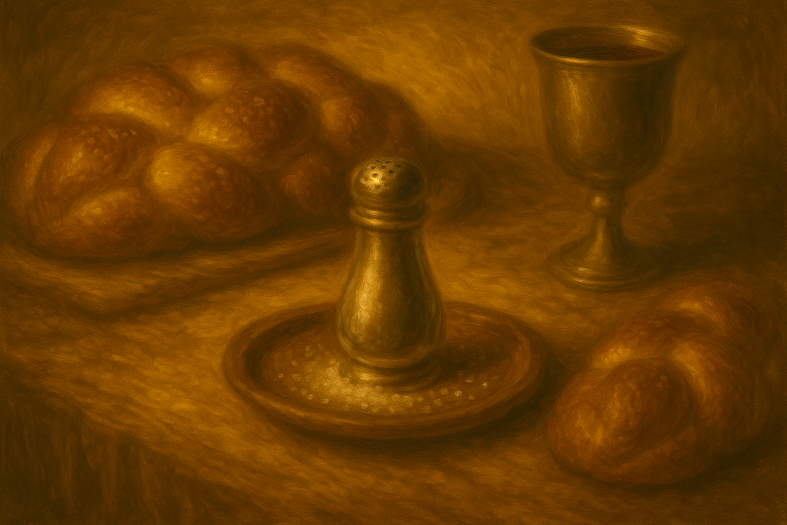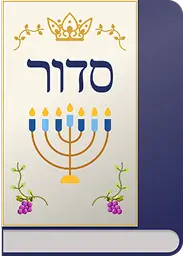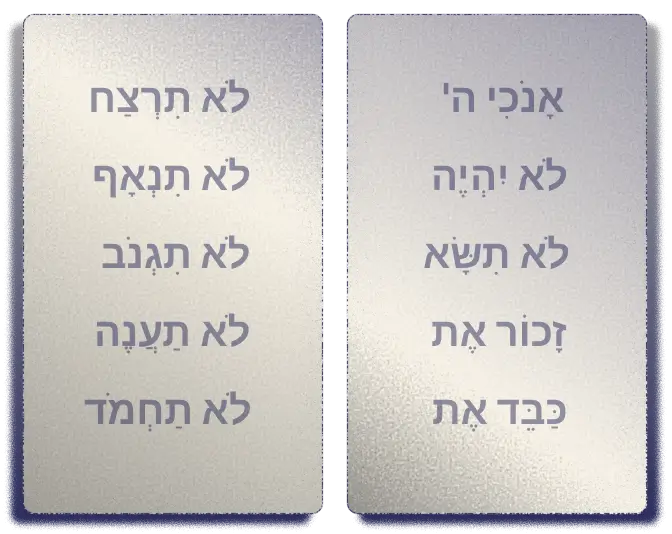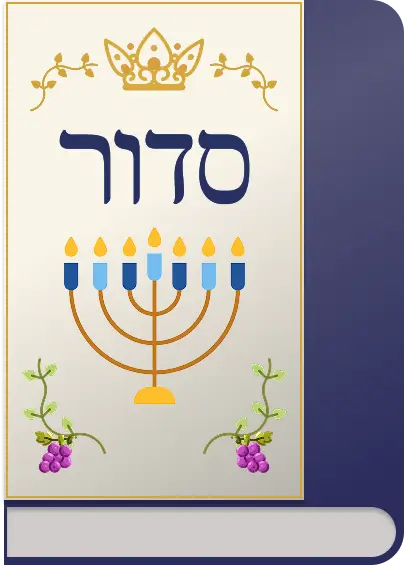

Salt is among the simplest elements in the physical world, yet within Torah it becomes one of the richest symbols of covenant, endurance, purification, and Divine intimacy. From the offerings of the Beis HaMikdash to the simple act of dipping challah on Shabbos, salt functions as a conduit through which the material is elevated into the realm of the sacred. Because salt does not decay, it becomes a natural metaphor for what is eternal — a sign of the enduring bond between Hashem and Am Yisrael.
Salt enters the Torah not as a minor seasoning but as a covenantal element woven into the very fabric of Creation:
“You shall not omit the salt of the covenant of your G-d from upon your offering; with all your offerings you shall offer salt.”
— Vayikra 2:13
Rashi, quoting Bereishis Rabbah (5:4), explains that the “covenant of salt” traces back to the earliest moments of the universe. When Hashem separated the upper and lower waters during Creation, the lower waters protested their distance from holiness. Hashem promised them that they would eventually be elevated on the Mizbeach — as salt on every korban and as water during the Sukkos libation (nisuch haMayim).
This midrash establishes salt as the fulfillment of a primordial promise — a sign of nearness to the Divine.
Ramban, expanding on Rashi, develops a profound theology of salt:
In Ramban’s formulation, salt is “the salt of the world” — the element through which the world can persist or be undone. Salt symbolizes the balance of Divine attributes and the durability of G-d’s covenant.
Salt thus becomes the symbol of permanence, elevation, and covenantal endurance — from the six days of Creation to every korban.
🧂Sources: Vayikra 2:13; Rashi ad loc.; Ramban ad loc.; Bereishis Rabbah 5:4.
Salt appears in another dramatic moment: the transformation of Lot’s wife into a pillar of salt (Bereishis 19:26).
Chazal draw meaning from the symbolism:
Salt here becomes a metaphor for transformation, for better or for worse.
🧂Sources: Bereishis 19:26; Rashi ad loc.; Maharal, Gur Aryeh.
The Tanach describes the promise of Davidic kingship as a “covenant of salt”:
“It is an everlasting covenant of salt before the Lord.”
— II Chronicles 13:5
Rashi explains that a bris melach signifies permanence, just as salt preserves and prevents decay. It is the Torah’s metaphor for an enduring, indestructible covenant.
Ralbag deepens the idea:
Salt preserves from corruption and spoilage, and therefore the phrase covenant of salt teaches that G-d’s promise to the House of David is firm, lasting, and stable throughout time. Ralbag adds that King Aviyah invoked this term to persuade Israel to abandon the corrupt practices introduced by Yeravam and return to Hashem and to the rightful Davidic monarchy — not to destroy them, but to bring them back to truth.
Salt thus becomes the emblem of faithfulness, permanence, and rightful kingship, reflecting a covenant that cannot decay.
🧂Sources: II Chronicles 13:5; Rashi ad loc.; Ralbag ad loc.
The Gemara (Menachos 20a) states unequivocally that every korban — animal, meal-offering, or incense — requires salt, fulfilling the Torah’s command, “With all your offerings you shall offer salt” (Vayikra 2:13).
Beyond the halachic requirement, Chazal attach rich layers of symbolism:
Salt thus emerges as a universal element of elevation, refinement, and covenantal distinction.
🧂Sources: Menachos 20a; Ramban on Vayikra 1:9.; Rambam, Moreh Nevuchim 3:46.
The Midrash teaches that when Hashem separated the upper and lower waters during Creation, the lower waters protested their distance from holiness. Hashem assured them that they would be brought close through two sacred rituals:
This is the origin of the Bris Melach — the covenant of salt.
Commentary:
🧂Sources: Vayikra 2:13; Rashi ad loc.; Ramban ad loc.; Bereishis Rabbah 5:4; Maharal; Sfas Emes (Vayikra).
Salt plays a central halachic role in preparing kosher meat because it draws out blood — something the Torah explicitly forbids for consumption (Vayikra 7:26; 17:10–14; Devarim 12:23). While the Written Torah establishes the prohibition, the Oral Torah provides the mechanism: melichah, salting with coarse salt, which extracts and expels blood from meat.
The Talmud (Chullin 113a–b) establishes that “melach k’mevashel dami” — salt functions like heat, pulling blood outward — and the Shulchan Aruch (Yoreh De’ah 69–78) codifies the detailed laws: rinsing the meat, applying coarse salt, allowing it to drain on an incline, and washing it afterward. Through this process, something previously prohibited becomes permitted.
Halachically and symbolically, salt becomes an emblem of refinement and elevation — the power to separate, purify, and transform. What was once unfit is rendered suitable through this act of boundary-making and sacred discipline.
🧂Sources: Vayikra 7:26; Vayikra 17:10–14; Devarim 12:23; Chullin 113a–b; Shulchan Aruch Yoreh De’ah 69–78; Rema ad loc.
The Midrash states:
“The world cannot endure without salt, and Israel cannot endure without Torah.” (Tanchuma; Jerusalem Talmud, Horayot 3:5:8-9)
Salt preserves and refines; so does Torah. Salt is the physical metaphor for spiritual endurance.
🧂Sources: Midrash Tanchuma (Vayikra, Siman 6); Jerusalem Talmud (Horayot 3:5:8-9).
Chazal describe the table as resembling the mizbeach.
Accordingly, the Shulchan Aruch rules:
“One should place salt on the table before hamotzi.” (Orach Chaim 167:5)
Just as every korban requires salt, so too our bread is sanctified through salt.
🧂Sources: Shulchan Aruch O.C. 167:5; Rema ad loc.
— Common Minhag: Dipping Three Times
This custom is widely practiced, with several layers of meaning:
The simple act of dipping challah becomes a mystical gesture of connection and refinement.
🧂Sources: Rema O.C. 167; Arizal, Sha’ar HaKavanos; Zohar Pinchas.
Salt heals, preserves, and enhances flavor — qualities the Maharal identifies with chesed, the Divine force that sustains existence and prevents decay. Just as chesed stabilizes and uplifts what would otherwise break down, salt preserves and refines, sweetening the harshness of din and protecting the integrity of what it touches.
Our Shabbos meal — a locus of blessing, presence, and unity — therefore begins with salt as a symbol of Divine preservation, refinement, and elevation.
🧂Sources: Zohar Pinchas; Maharal (Gevurot Hashem 5–6; Tiferet Yisrael 40).
Many Jewish homes maintain the practice of keeping salt on the table throughout the meal — and in some traditions, at all times.
The Zohar (Pinchas 219b) teaches that salt “sweetens judgments,” preventing harsh spiritual forces from dominating.
Just as the altar was never without salt, so too the Jewish table — the micro-altar — remains a place of covenant and blessing.
Salt reminds us of the moral failures of Sodom and the mitzvah of hachnasas orchim.
Keeping salt on the table becomes a quiet reminder of ethical responsibility.
🧂Sources: Zohar Pinchas 219b; Shulchan Aruch O.C. 167; Rema ad loc.
Salt represents:
Because the Shabbos table mirrors the altar — and every korban required salt.
It signifies covenant, protection, refinement, and the constant presence of holiness.
Salt becomes a reminder:
In the end, salt — so small, so ordinary — becomes one of the Torah’s most profound metaphors. It binds covenants, elevates sacrifices, sweetens judgments, and surrounds the Jewish table with meaning and memory. From Creation itself, when the “lower waters” longed for closeness to the Divine, salt was destined to rise, to be lifted from the physical world into the service of Hashem. Each pinch of salt on our challah, each grain resting upon our Shabbos table, reminds us that holiness is not reserved for the extraordinary. It is found in the simple acts, the quiet gestures, and the enduring commitments that preserve, refine, and elevate our lives. Salt teaches us that even the smallest element can become a bridge to the eternal — when placed in the service of the One Who sanctifies all things.







Midrash Bereishis Rabbah 5:4 — The “lower waters” lament being distanced; Hashem elevates them through salt offered on every korban. Salt becomes part of Creation’s original tikkun and covenant.
Lot’s wife becomes a pillar of salt — measure for measure for withholding salt from guests (Rashi). Salt here symbolizes the boundary between preservation and corruption.
“With all your offerings you shall offer salt” (Vayikra 2:13) — Salt is required on every korban, forming the Bris Melach, the covenant of permanence (Sforno; Ramban).
“A covenant of salt forever” (Bamidbar 18:19) — Salt represents eternity and incorruptibility in the priestly covenant.
Davidic kingship as a “covenant of salt” (II Chron. 13:5) — The same symbolism of permanence applied to monarchy.
The Shabbos table is compared to the Mizbeach; challah is dipped in salt to complete the korban imagery (Shulchan Aruch OC 167; Rema).
Salt removes blood (Devarim 12:23), turning what is prohibited into something permissible — symbolizing purification and elevation.


#348 — To salt all sacrifices — Leviticus 2:13
Core mitzvah of bris melach — every korban requires salt, making salt the universal element of elevation and covenant. Salt embodies permanence and the uplifting of the “lower waters” onto the Mizbeach.
Narrative / halachic roots: Vayikra 2:13; Menachos 20a; Bereishis Rabbah 5:4; Ramban and Sforno ad loc.
#349 — Not to omit the salt from sacrifices — Leviticus 2:13
Negative command that guards the covenant; an offering lacking salt is spiritually incomplete. The article uses this to frame why our Shabbos bread, mirroring a korban, is never without salt.
Narrative / halachic roots: Vayikra 2:13; Shulchan Aruch O.C. 167; Rema ad loc.
#192 — Not to eat blood — Leviticus 3:17
Salt’s role in kashering meat — drawing out blood — turns something prohibited into something permitted. Salt becomes a symbol of purification and transformation of the physical into the spiritual.
Narrative / halachic roots: Vayikra 3:17; Shulchan Aruch Yoreh De’ah 67–69.
#204 — To ritually slaughter an animal before eating it — Deuteronomy 12:21
The article connects shechitah and subsequent salting as a process of refinement: from raw animal life through halachic slaughter and salt-assisted kashering to a sanctified meal.
Narrative / halachic roots: Devarim 12:21; Chullin 27a; Shulchan Aruch Y.D. 1–2, 67–69.
#336 — To offer only unblemished animals — Leviticus 22:21
Unblemished korban plus covenantal salt illustrates the ideal of purity and wholeness in avodah — both the offering and the “seasoning” must express integrity and elevation.
Narrative / halachic roots: Vayikra 22:21; Malachi 1; Rambam, Hilchos Issurei Mizbeach.
#301 — To build a Sanctuary (Holy Temple) — Exodus 25:8
The Beis HaMikdash, with its altar and salted offerings, becomes the macro-model for the Jewish table as a miniature Mizbeach. The mitzvah of Mikdash underlies the article’s move from Temple to Shabbos table.
Narrative / halachic roots: Shemos 25:8; Zohar on “shulchano shel adam mechaper alav”; Chazal equating dining table with altar.
#87 — To rest on the seventh day — Exodus 23:12
Shabbos is the setting in which the symbolism of salt is most visible — the Shabbos meal as sacred pause, where rest, Presence, and covenant are tasted through salted challah.
Narrative / halachic roots: Shemos 23:12; Yeshayahu 58:13; Zohar on Shabbos meals as korban-like avodah.
#91 — To sanctify the day with Kiddush and Havdalah — Exodus 20:8
Kiddush verbally sanctifies Shabbos; salt on the challah physically echoes the Mizbeach. Together, word and substance seal Shabbos as a living bris at the table.
Narrative / halachic roots: Shemos 20:8 (“Zachor es yom haShabbos”); Pesachim 106a; Shulchan Aruch O.C. 271, 167.
#85 — To bless the Almighty after eating — Deuteronomy 8:10
The article frames the meal — beginning with salted bread and concluding with Birkat HaMazon — as a full arc of covenant: physical enjoyment, refined through salt, crowned with verbal thanksgiving.
Narrative / halachic roots: Devarim 8:10; Berachos 20b–21a; Shulchan Aruch O.C. 184.

Dive into mitzvot, prayer, and Torah study—each section curated to help you learn, reflect, and live with intention. New insights are added regularly, creating an evolving space for spiritual growth.

Explore the 613 mitzvot and uncover the meaning behind each one. Discover practical ways to integrate them into your daily life with insights, sources, and guided reflection.

Learn the structure, depth, and spiritual intent behind Jewish prayer. Dive into morning blessings, Shema, Amidah, and more—with tools to enrich your daily connection.

Each week’s parsha offers timeless wisdom and modern relevance. Explore summaries, key themes, and mitzvah connections to deepen your understanding of the Torah cycle.